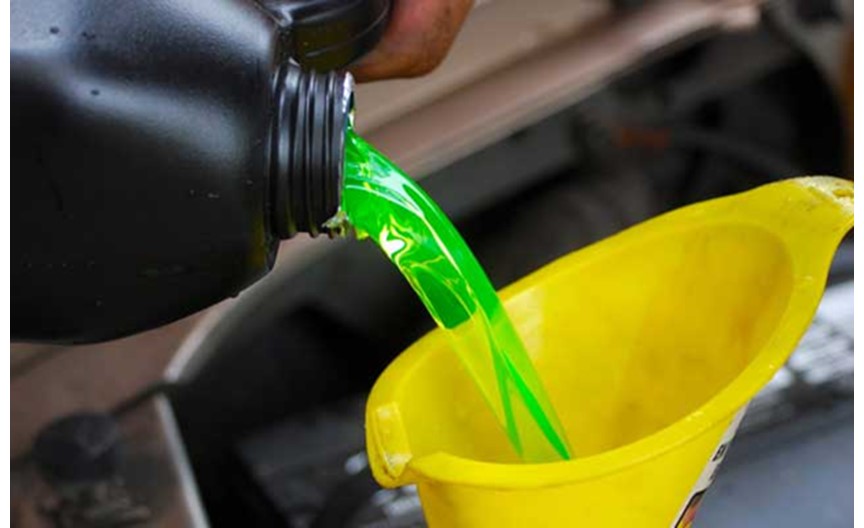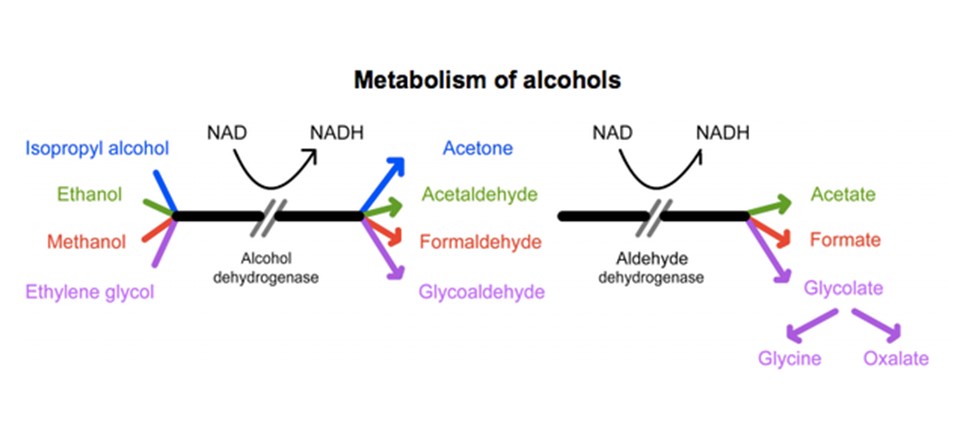TOXICOLOGY QUESTION OF THE WEEK
October 13, 2023
What toxicities are caused by toxic alcohols and their metabolites?
Toxic alcohols are present in commonly used products such as Radiator Antifreeze and Windshield washer fluids, and most homes may have large gallon jugs of these products in their garages. They often have a pleasing color, are odorless, and may even taste good!
Beware…. these products can cause severe toxicity if ingested, and maybe easily accessible to small children and pets!

Antifreeze has Ethylene Glycol and Windshield washer fluid has Methanol, both parent compounds are metabolized to toxic end products that can cause severe toxicity.
Metabolism of all alcohols including Ethanol and Isopropyl alcohol is via Alcohol dehydrogenase. Ethylene glycol and Methanol toxicity is due to their metabolites: EG is metabolized to Glycolic and Oxalic acids and can cause renal toxicity; and Methanol is metabolized to Formic acid and can cause Ocular toxicity; both cause metabolic acidosis with an elevated anion gap. Isopropyl alcohol is metabolized to acetone, which is eliminated via the kidneys, this does not cause metabolic acidosis.

Absorption is quick and the parent compound may only cause mild intoxication, vomiting and gastritis. Significant clinical symptoms and laboratory abnormalities may only be noted after a delay during which the toxic alcohol is metabolized to its metabolites. Initial labs may show an Osmol gap indicating the presence of unmetabolized toxic alcohol. Serum Osmolality can be checked at most hospital labs, and the Osmol gap can be calculated: it is difference between measured osmolality and calculated osmolality. As these toxic alcohols are metabolized, the osmolar gap decreases and patient will develop an anion gap metabolic acidosis and finally end organ toxicity. Specific lab tests would be Ethylene glycol or Methanol levels, these labs may not be obtainable at most hospital laboratories.
If the patient presents early, treatment is aimed at prevention of metabolism of the parent compound by inhibiting the enzyme alcohol dehydrogenase. Fomepizole is the specific antidote that acts as a competitive inhibitor of this enzyme and can be administered every 12 hours. If it is not available, regular Ethanol can be used to achieve a blood alcohol level of 100 mg/dL as it acts as a competitive substrate for this enzyme, which has a higher affinity for Ethanol than for other alcohols. This will allow time for the parent compound to be eliminated unmetabolized, preventing toxicity.
If the patient presents late and has already started to metabolize the toxic alcohol, they may present with both an Osmol gap and an Anion gap metabolic acidosis. Hemodialysis is the definitive therapy, as it removes both the parent compound and the toxic metabolites and corrects the acid base disorder. Some patients may require multiple rounds of hemodialysis, during which Fomepizole will need to be dosed every 4 hours to maintain therapeutic concentrations. Adjunctive therapy may include Sodium bicarbonate, folic acid, thiamine, and pyridoxine.
REFERENCES
Goldfrank’s Toxicologic Emergencies
Poisoning and Drug Overdose (Lange Clinical Manual)
https://www.acep.org/toxicology/newsroom/Oct2020/toxic-alcohols
https://www.nejm.org/doi/full/10.1056/nejmra161529
https://aliemcards.com/cards/methanol/
Question submitted by Suparna Kumar MD, CSPI
Comment: This is a nice overview. There is always so much confusion about the treatment of the toxic alcohols. It is important to realize that this is a dynamic process. The osmolar gap tells you how much alcohol has yet to be metabolized. The anion gap is a result of the acidosis that occurs when the alcohol has been metabolized. Fomepizole stops the metabolism, so you only administer fomepizole when you have an osmolar gap. If toxic alcohol concentrations are not available, it is appropriate to consider Fomepizole based on the osmolar gap. Bicarb treats the acidosis, it does nothing to the metabolism. ds
The NEJM article is an excellent review. Next week, a case discussion of toxic alcohols.
I am interested in any questions you would like answered in the Question of the Week. Please email me with any suggestions at donna.seger@vumc.org.
DONNA SEGER, MD
Professor Emeritus
Department of Medicine
VUMC
|
|
TENNESSEE POISON CENTER 24/7 FREE MEDICAL HOTLINE
POISON HELP | 800.222.1222 |